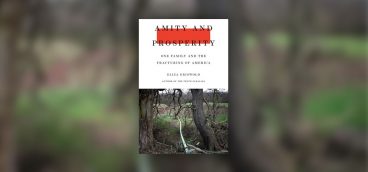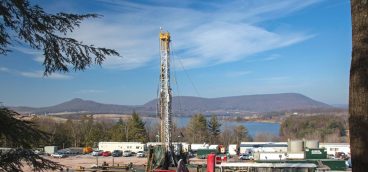
If you want to explore the vexing subject of global climate change, Seamus McGraw is the guy to have as a tour guide. He will not torture your brain with elaborate science, tax your patience with lectures about evil consumer habits, or bash you over the head with partisan arguments. Instead, he takes you to people across the nation who know what they are talking about—scientists, outdoorsmen, farmers—and presents their findings with a reporter’s rigor and the knack of a raconteur.
A writer from rural northeast Pennsylvania, McGraw is the author of “The End of Country: Dispatches from the Frack Zone,” an evenhanded yet passionate report of the gas-drilling boom that changed his region. (He is also a national award-winner for his Marcellus Shale writing for Pittsburgh Quarterly.) “Betting the Farm on a Drought” opens on his property, where he has leased land for fracking, and not without trepidation. As McGraw notes elsewhere in the book, he is a “good old-fashioned dyed-in-the-wool liberal.” According to that political orientation, he should be dead-set against the extraction of fossil fuels from his or any other land. Yet he observes the fact, quoting an expert from the International Energy Agency, that “in the past five years there’s little doubt that gas was the most important factor in bringing down carbon dioxide emissions” in the U.S., far outstripping gains in renewable energy such as solar and wind power.
Setting the theme for the rest of the work, McGraw stakes out a middle ground that seems radical these days: “Could we figure out a way to use the raw power that had been unleashed here, not just the energy in the gas but the crude instincts of the industry, and the driven activism of its opponents, to channel a response to the dual dangers of climate change and fracking and find a way forward?”
McGraw is an energy-efficient writer. Within these 161 pages, he traverses the continent, interviewing over 20 substantial people, distilling complicated topics and conveying emotions with respect and care. The handful of photographs are also highly effective at enhancing the human touch.
The story of Ethan Cox provides the book’s title. Cox, 65, a third-generation Illinois farmer of corn and soy, has barely survived two years of flooding from “storms of amazing fury” when we meet him in early 2012. The meteorologists and other experts, expecting another soggy year, were advising farmers to plant in late March. But Cox “knew how to read the signs on his own land,” a skill passed down from his father, “who didn’t know the first thing about interdecadal variations in ocean temperatures.” He feels a drought coming on. So he plants early, making use of the moisture left behind—and “having listened to his land, harvested early and had one of his best crops in years.”
Cox, meanwhile, doesn’t much believe that guff about anthropogenic climate change. In any case, “I’ve never met a liberal before,” he tells McGraw, before they settle down for a two-hour chat about everything under the sun. The author’s gift for empathy serves everyone well. He finds “enough common ground to find a shared purpose” on about 85 percent of what they talked about, 10 percent “where we could at least reach an understanding” and 5 percent “where the differences were just too great”—but those could be set aside.
McGraw asserts that “there are profound lessons that must be learned from folks like Ethan Cox and Joe Leathers”—a Texas rancher hammered by drought but who says “the worst thing anybody can do is think the idea that this is some sort of man-made problem and get men to try to fix it.” McGraw’s message for his fellow liberals: “These are people who, even if they don’t believe in man-made climate change, are adapting to the consequences of a wild climate nonetheless.”
In other words: If the carbon-reduction pledges made at the 2015 Paris climate conference don’t do the trick, we need people who know how to adapt—or die, as the saying goes.
McGraw draws on the influential climate scientists at Penn State: Klaus Keller, Michael E. Mann and particularly Richard Alley, who occupies the book’s last chapter. For more than a decade, Alley has been “among the leading voices warning about the dangers of melting ice caps and sea level rise.” Yet he is “an astoundingly optimistic man,” one who can be found most Sunday mornings at a Methodist church in State College, “belting out old hymns.” He and his colleagues “are certain that we have already churned out enough greenhouse gases to lock in formidable challenges well into the future.” But Alley says “it’s not that if we wait 10 years then everything is doomed, and we’re all going to die. I think we’re weeds.”
Marinating himself in the fine points of the planet’s greatest existential threat for months on end, McGraw has emerged with a hard-earned sense of optimism, a belief in “that most renewable of American resources, a sense of hope.” His work is a breath of fresh air.
Short Takes: New selections from Pittsburgh authors
As a poet, Peter Oresick covers all the bases. He can write in the formal cadences of the modern style, establishing his bona fides in the academic world he has inhabited for decades in a rich career ranging from the University of Pittsburgh, Chatham and Carnegie Mellon to Emerson College in Boston. But he also delivers crowd-pleasing verse—with integrity, not E-Z tricks. Consider the opening of “Fired/On my 49th Birthday”: After the firing, after the boxed drawers, / the perp walk to the parking lot / the acids of shame, the frankness of banks, / after gin & tonic, DVDs, golf without end, / a new normal grows. It’s one of the many works in “Iconoscope” that jump off the page and dance.
Born in 1955 to a Ruthenian family of industrial laborers in Ford City, Oresick maintains a reverence for hard work and the beauty of his religious heritage. In his bones is an appreciation for Andy Warhol that few can match, as the selected poems from his 2008 collection “Warhol-O-Rama” show (“Ah, Rusyn brother, pallid pal, weird old impudence teacher” is one choice line).
And, as in “Toward the Heaven of Full Employment,” he’s enough of a regular guy to know when to make a poem rhyme: Out of love for dead Kennedys, / out of fear of her laid-off spouse, / Aunt Sophie lit candles and prayed an extra rosary / so God would make the payment on the house.
Barbara Burstin has a hard act to follow: herself. “Steel City Jews,” her exhaustively researched 2009 book, covered the early years, 1840–1915. In these pages, reviewer Sandra Levis raved that Burstin “examines, intelligently and effectively, what it meant to practice Judaism in an area known as the ‘Presbyterian Valley.’ ” The book made clear that “Jews were actually among the earliest pioneers in this region” and that readers “will find themselves wishing for a second volume in Burstin’s words to bring the rest of the story to life.”
Burstin maintains the standards established with first volume, tracking down every significant player and event, with the rigor of a scholar. (She earned her Ph.D. in history at University of Pittsburgh, where she teaches courses on the Holocaust and the U.S. response to it; she also teaches at CMU.)
As she chronicles the growing strength and depth of Pittsburgh’s Jewish community, through the global cataclysms of two world wars and the Holocaust, Burstin documents the shameful acts of bigotry, both large and small, they endured. Yes, it was the era of “restricted” private clubs, but ponder this image: Edgar Kaufmann and his wife had to pack a lunch “when they went to see polo matches at the Rolling Rock Country Club in Ligonier since they were not allowed to eat in the clubhouse.”
Burstin does not shy away from detailing conflicts within the Jewish community, from the “bitterness and division on the issue of Zionism… played out with lingering acrimony, resentment, even antagonism between the Jews of Eastern Europe versus German origin,” to kerfuffles within the Jewish Family Welfare Association in 1927. But her overall story is one of success. By 1950, Pittsburgh’s Jewish citizens “had arrived at solid middle-class status entrenched in strong city neighborhoods.” After a long, hard journey, they “were finally arriving,” she concludes, the past-continuous verb tense suggesting that a third volume is in the works. Here’s hoping that Myron Cope gets the full scholarly treatment.
It would be hard to over-estimate the central role that Morton “Moe” Coleman has played in Pittsburgh civic and political life over the past six decades. “I became a neighborhood organizer by accident,” he writes, with typical modesty, in this brisk yet comprehensive memoir of his career.
Moe (meet him once and you’re on first-name basis forever) took his advanced degrees from Pitt in social work and political science, but you get the feeling that everything he’s learned came from real-life experience. From advancing civil rights in the Hill District in the 1950s to the office of Mayor Joseph Barr in the 1960s to the School of Social Work at Pitt and later creating the Institute of Politics there, Moe is the ultimate people person—listening, connecting, caring and making things happen. We may not see someone like him again, except that all the good he has instilled in others will surely carry on.





